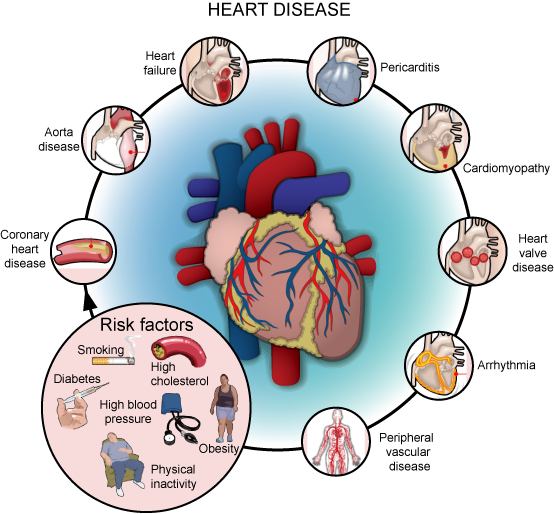Heart disease is a term covering several disorder of the heart. Unlike cardiovascular disease, which describes problems with the blood vessels and circulatory system as well as the heart, heart disease refers to issues and deformities in the heart itself. Some companies provide best ayurvedic tonic for heart, ayurvedic medicine for heart disease and also natural remedies for heart health to prevent heart diseases.
Facts on heart disease
- One in every four deaths in the U.S. is related to heart disease.
- Some examples of heart disease - Coronary heart disease, arrhythmia, and myocardial infarction.
- Heart disease might be treated with medication or surgery.
- Quitting smoking and exercising regularly can help prevent heart disease.
Types
There are several types of heart disease that affect different parts of the organ and occur in different ways.
Congenital heart disease
This is a general term for certain deformities of the heart that have been present since birth. Examples include:
- Septal defects, means there is a hole between the two chambers of the heart.
- Obstruction defects: The flow of blood through various chambers of the heart is partially or totally blocked.
- Cyanotic heart disease, which is a defect in the heart, causes a shortage of oxygen around the body.
Arrhythmia
Arrhythmia is an irregular heartbeat. There are a number of ways in which a heartbeat can lose its regular rhythm. These include:
- tachycardia, when the heart beats too fast
- bradycardia, when the heart beats too slowly
- premature ventricular contractions, or additional, abnormal beats
- fibrillation, when the heartbeat is irregular
Arrhythmia's happen when the electrical impulses in the heart that coordinate the heartbeat do not work properly. These make the heart beat in a way it should not, whether that be too fast, too slowly, or too erratically. Irregular heartbeats are common, and all people experience them. They feel like a fluttering or a racing heart. However, when they change too much or happen because of a damaged or weak heart, they need to be taken more seriously and treated. Arrhythmia's can become fatal.
Coronary artery disease
The coronary arteries supply the heart muscle with nutrients and oxygen by circulating blood. Coronary arteries can become diseased or damaged, usually because of plaque deposits that contain cholesterol. Plaque build-up narrows the coronary arteries, and this causes the heart to receive less oxygen and nutrients.
Dilated cardiomyopathy
The heart chambers become dilated as a result of heart muscle weakness and cannot pump blood correctly. The most common cause is that not enough oxygen reaches the heart muscle, due to coronary artery disease. This usually affects the left ventricle.

Myocardial infarction
This is also known as a heart attack, cardiac infarction, and coronary thrombosis. An interrupted blood flow damages part of the heart muscle. This is usually caused by a blood clot that develops in one of the coronary arteries and can also occur if an artery suddenly narrows or spasms.
Heart failure
Also known as congestive heart failure, heart failure occurs when the heart does not pump blood around the body efficiently. The left or right side of the heart might be affected. Rarely, both sides are. Coronary artery disease or high blood pressure can, over time, leave the heart too stiff or weak to fill and pump properly.
Hypertrophic cardiomyopathy
This is a genetic disorder in which the wall of the left ventricle thickens, making it harder for blood to be pumped out of the heart. This is the leading reason of sudden death in athletes. A parent with hypertrophic cardiomyopathy has a 50 percent chance of passing the disorder on to their children.
Mitral regurgitation
Also known as mitral valve regurgitation, mitral insufficiency, or mitral incompetence, this occurs when the mitral valve in the heart does not close tightly enough. This lets blood to flow back into the heart when it should leave. As a consequence, blood cannot move through the heart or the body efficiently. People with this type of heart condition often feel exhausted and out of breath.
Mitral valve prolapse
The valve between the left atrium and left ventricle does not fully close, it bulges upwards, or back into the atrium. In most people, the condition is not life-threatening, and no treatment is required. Some people, especially if the condition is marked by mitral regurgitation, may require treatment.
Pulmonary stenosis
It becomes hard for the heart to pump blood from the right ventricle into the pulmonary artery because the pulmonary valve is too tight. The right ventricle has to work harder to overcome the obstruction. An infant with severe stenosis can turn blue. Older children will generally have no symptoms. Treatment is needed if the pressure in the right ventricle is too high, and a balloon valvuloplasty or open-heart surgery may be performed to clear an obstruction.
According to the Centers for Disease Control (CDC), heart disease is the leading cause of death in the United Kingdom, United States, Canada, and Australia. One in every four deaths occurs as a result of heart disease in the U.S. In many countries they use natural treatments for heart disease or natural medicines for heart disease.
Comments
Post a Comment